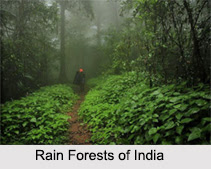Rainforests
of India are located mostly in the north-eastern corner of the country in the
state of Assam.
It may be mentioned here that Rain forests, as the name suggests, are those
forests, which are characterized by high annual rainfall of around 1750mm to
2000mm. The global distribution of equatorial rainforest is closely tied to the
warm, moist climates that occur near to the Equator. India is located in
Southern Asia between Burma and Pakistan. Here tropical rain forests are to be
seen. A tropical rainforest is one which is wet and warm throughout the year.
It is hot and humid here in these regions. Tropical rain forests are located
near the equator and the tropic of cancer.
Features of Indian Rain forests
The tropical vegetation of India in the north eastern side (which includes the
states of Assam, Nagaland,
Manipur, Mizoram, Tripura and
Meghalaya as well as the plain regions of Arunachal Pradesh) are most typically seen at elevations of upto 900metres.
They encompass evergreen and semi-evergreen rain forests, riparian forests,
moist deciduous monsoon forests and swamps and grasslands. In the Rainforests
of the Assam Valley, the giant Dipterocarpus macrocarpus and Shorea assamica
occur singly. They can occasionally attaining a girth of up to 7 m and a height
of up to 50 m. The monsoon forests are mainly moist sal Shorea robusta forests,
which occur widely in this region. The Andamans and Nicobar islands have
tropical evergreen rain forests and tropical semi-evergreen rainforests as well
as tropical monsoon moist monsoon forests. The dominant species is
Dipterocarpus grandiflorus in hilly areas, while Dipterocarpus kerrii is
dominant on some islands in the southern parts of the archipelago. The monsoon
forests of the Andamans are dominated by Pterocarpus dalbergioides and
Terminalia sap.
Animals Found in Indian Rain Forests
Various different kinds of animals are found inhabiting the Indian rain forests. They are Howler monkeys which live in the canopy of the rain forest, Pythons, Vinesnake, Elephant, Sloth, many different kinds of Bats, Jaguars, Tapirs which are rather difficult to spot in the forest, Chameleon, Crested Guan which live in the lowland rain forest region, Tiger, King Cobras, Gecko which lives high up in the rain forest, Bearded Dragon, Slow Loris and Gibbon which live in the canopy. There are many more animals that live in India's rain forests. A lot of the animals are endangered. The clouded leopard, flying squirrel, leopard, tiger and Indian bison are just a few. Some birds that are endangered are pheasants, eagles, owls, wood ducks and hornbills. To know more read:
Various different kinds of animals are found inhabiting the Indian rain forests. They are Howler monkeys which live in the canopy of the rain forest, Pythons, Vinesnake, Elephant, Sloth, many different kinds of Bats, Jaguars, Tapirs which are rather difficult to spot in the forest, Chameleon, Crested Guan which live in the lowland rain forest region, Tiger, King Cobras, Gecko which lives high up in the rain forest, Bearded Dragon, Slow Loris and Gibbon which live in the canopy. There are many more animals that live in India's rain forests. A lot of the animals are endangered. The clouded leopard, flying squirrel, leopard, tiger and Indian bison are just a few. Some birds that are endangered are pheasants, eagles, owls, wood ducks and hornbills. To know more read:


























